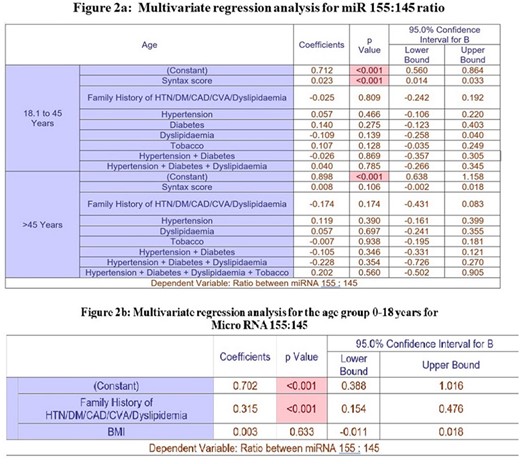-
PDF
- Split View
-
Views
-
Cite
Cite
A Banerjee, D Roy, H Mazumdar, S Karmakar, R Bhowmik, N Biswas, A Roy, S Dey, K Manna, MicroRNA 155:145 ratio as a marker of atherogenic tilt manifested across different age groups and risk factor profiles, European Heart Journal, Volume 43, Issue Supplement_1, February 2022, ehab849.063, https://doi.org/10.1093/eurheartj/ehab849.063
Close - Share Icon Share
Abstract
Type of funding sources: None.
Differential expression of microRNAs is critical in the genesis and progression of atherosclerosis. MiR145 has atheroprotective role through improved homeostasis of smooth muscle cells (SMC). MiR155 is pro-atherogenic due to its suppression of Bcl6, which antagonises NF-κB and modulates macrophages.
Our purpose was to determine if the differential expression of miR 155 & 145 (expressed as miR 155:145 ratio) across various age groups and risk factor profiles correlates with atherosclerotic cardiovascular disease (ASCVD).
This observational cross-sectional study was done between Feb"19 & Jan"20 on 108 patients divided equally into 3 age groups: <18, 18-45 & >45yrs. Family history (of ASCVD or risk factors) and risk factor profile were assessed in all 3 groups; and in the latter two, presence or absence of ASCVD was additionally evaluated by coronary angiogram and/or carotid IMT. MiR155 & 145 were measured in all by RT-PCR, & the results were then compared after calculating the ratio.
miR 155:145 ratio was significantly increased in <18yrs aged subjects with a positive family history(p = 0.001). Multivariate regression analysis revealed a significant positive correlation of miR155:145 with family history of risk factors or ASCVD in this group(p < 0.001).
In the 18-45yrs age group, the miR 155:145 ratio was found to be significantly increased in patients with diabetes(p = 0.037) and significant coronary artery disease(CAD) as determined by Syntax score(p < 0.001). In multivariate regression analysis, a significant positive correlation was found between miR 155:145 and Syntax score(p < 0.001) – a ratio of 155:145 > 1 implied a greater chance of CAD, with increased numerical values correlating with increased severity of disease as evidenced by Syntax score; and a ratio < 1 decreased the chances of significant CAD considerably. A positive association was also discovered for this ratio with hypertension, diabetes, tobacco exposure and a combination of multiple risk factors, but none of them were statistically significant.
In the age group of >45 yrs, regression analysis revealed a statistically insignificant positive association of the miR 155:145 ratio with Syntax score, hypertension, dyslipidaemia and a combination of risk factors.

Abstract Figure 1

Abstract Figure 2
- atherosclerosis
- dyslipidemias
- coronary angiography
- hypertension
- coronary arteriosclerosis
- diabetes mellitus
- diabetes mellitus, type 2
- homeostasis
- macrophages
- reverse transcriptase polymerase chain reaction
- tobacco
- micrornas
- myocytes, smooth muscle
- carotid intima-media thickness
- severity of illness
- syntax



